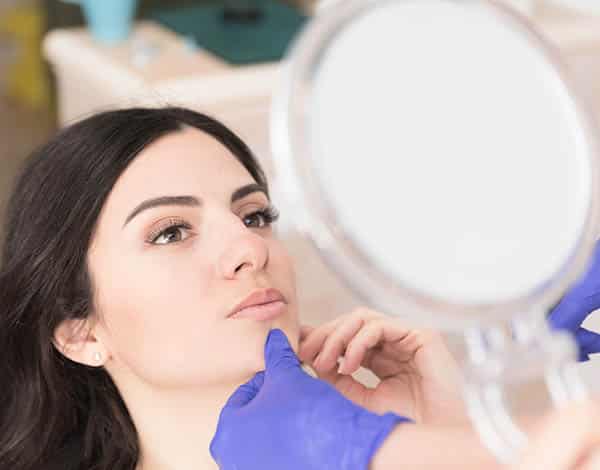For patients seeking a way to enhance their profiles, they may consider profiloplasty. This is a non-surgical, non-invasive treatment used to create a more balanced appearance to the face. Instead of surgery, dermal fillers are used for chin augmentation, rhinoplasty, and lip enhancement. Together, these alterations result in more balanced facial proportions. When patients come in for consultations, they often do not realize how much each facial feature influences the appearance of the others; indeed, many cite their most dominant aesthetic features as the area of concern.
During consultations, clinicians assess the face in its entirety and counsel the patients about aesthetic proportions of their features. They will discuss how to optimize the features. The ideal chin-nose ratio has been theorized by plastic surgeon Dr. Mario Gonzalez-Ulloa, and it is intended to optimize the proportions. If we imagine two lines drawn, one will pass through the interior margin of the orbit and upper margin of the ear (external auditory meatus). It is also tangential to the nasion, and the zero meridian is found at the midline and point of the deepest nasal root. The second line will be perpendicular to this. A face with ideal proportions will possess a chin with a point that will be on this line or just posterior to it.
The Treatment
The advantage specifically to profiloplasty treatment, is avoiding the high costs and complications associated with surgery, such as forms of trauma and scarring. Once the facial features assessment is completed at a consultation appointment prior to an actual procedure, Dr. Yusra Al-Mukhtar suggests choosing a dermal filler that has a high-volumizing capacity and technical hardness (G prime). Gels with these properties specifically, are highly cross-linked and tend to last longer. Many contain local anesthetics as well (such as lidocaine), for easing pain levels in areas that are particularly sensitive.
The procedure consists of strategic injections of dermal filler into the nose. The placements hide the dorsal hump, straighten out the bridge of the nose, and elevate the tip. Together, these injections shorten the nose. Chin size and posture, which includes anterior projection, length, and symmetry may have to be modified as they are required for an aesthetically correct result. A chin that recedes can cause the illusion of a bigger nose, so achieving balance between these two dominant features is important for a proportionate look. Once all the details are adjusted, the final look mimics a more ideal skeletal structure.
Side Effects and Complications
Since the procedure relies so heavily on dermal fillers, the contraindications are the same to any other dermal filler procedure. Patients who are pregnant, breastfeeding, have a suppressed immune system, or tend to develop keloid scarring should avoid this treatment. During counselling, patient expectations should be managed as well; those with larger noses, dorsal humps, and severe skeletal bases may not be able to obtain the same results as patients with less prominent feature, so it may be in their best interest to consider surgical procedures.
Side effects are limited to swelling and bruising that dissipate within four weeks. Normally, the chin becomes very tender and swollen due to muscle stiffness in the area. However, pain can be managed with over-the-counter analgesics. There is the possibility of serious complications such as infection or necrosis. Patients should be advised to avoid touching the areas treated and applying makeup for at least a day, as this can help limit pain and the development of an infection. Necrosis may occur due to vascular occlusion; this is extremely rare but serious. The risk of occlusion is significantly minimized when patients see experienced practitioners who follow injection protocols strictly and have a strong understanding of facial anatomy.
In order to ensure that a needle has not pierced a blood vessel, Dr. Yusra recommends using aspiration as a safety measure. It is crucial to make sure that the injection is deep, that it is close to the bone or cartilage, and that the filler should be injected slowly in small increments. Signs of occlusion such as skin blanching will be visible relatively early, and it should be treated immediately by dissolving the filler with hyaluronidase, an enzyme that breaks down hyaluronic acid. If patients notice any changes in skin colour or condition, such as whitening, ulceration, or blisters, they should return for urgent treatment. They must also be advised that the nose is a high-risk injection site due to its vasculature.
Conclusions
Profiloplasty offers many of the changes associated with traditional cosmetic surgery in terms of enhancing the profile while simultaneously bypassing the potential trauma, scarring, and high costs associated with surgery. Class II skeletal patients are eligible for this cosmetic enhancement to modify the proportions of their profiles, and the results will last between 12 to 18 months. However, practitioners should counsel patients about any risks associated with the procedure and manage their expectations. Experienced injectors will minimize the possibility of occlusion or infection by following safe injection techniques. Patients will find their proportions more balanced and harmonious at the end of a successful profiloplasty treatment.





















